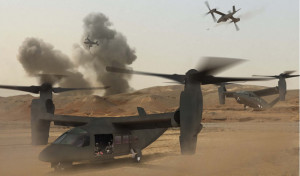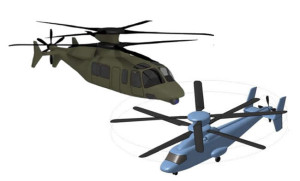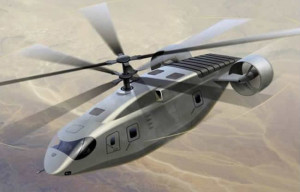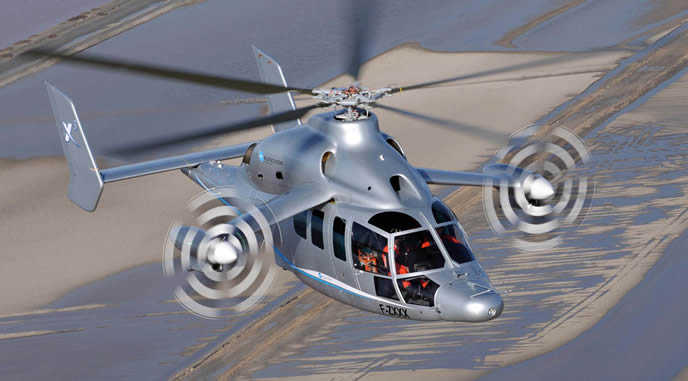

Updated March 6, 2013: Sikorsky Aircraft Corp., and Boeing have signed a teaming agreement on Jan. 13, to submit a joint proposal in response to the U.S. Army Aviation Applied Technology Directorate solicitation for the Army’s Joint Multi-Role (JMR) Technology Demonstrator (TD) Phase 1 program. The proposal will be based on Sikorsky’s X2 Technology rotorcraft design. Sikorsky will take the lead role in this JMR TD Phase 1 proposal, and Boeing will take a lead role for Phase 2, the mission systems demonstrator program.
According to Leanne Caret, vice president and general manager of Boeing’s Vertical Lift division, the two companies are fully committed to the long-term nature of the Future Vertical Lift initiative, and we will contribute equally in terms of capital, technological capability and risk on our path to meeting the Army’s requirements.
The JMR TD supports the Department of Defense’s Future Vertical Lift program to deliver the next generation of vertical lift aircraft with greater performance, reliability and affordability. The team will compete to build and fly one or more demonstrator aircraft in 2017 to be evaluated for next-generation vertical lift performance in a medium-lift-sized aircraft.
“The Sikorsky and Boeing proposal will demonstrate how X2 Technology, with its counter-rotating coaxial main rotors, pusher propeller, and advanced fly-by-wire system, will deliver efficient 230-knot cruise airspeed, improved hover efficiency, and weight-optimized design in an affordable package,” said Samir Mehta, president of Sikorsky Military Systems. “By leveraging our proven design, we can offer the Army reduced risk, a 100-knot improvement in speed, a 60 percent improvement in combat radius, and 50 percent better high-hot hover performance.”
Sikorsky intends to develop and fly two S-97 Raider prototypes by 2014, leveraging the coaxial-compound rotor-pusher-propeller combination that took Sikorsky’s X2 demonstrator to a speed of 268 mph in 2010, breaking the world’s helicopter speed record. The S-97 is designed to be a 10,000lb-class helicopter while the design gross weight (DGW) of the JMR Phase 1 aims at three times that weight – 30,000 lb. The teaming with Boeing will enable the company to rely their proposal to include part of the experience Boeing has gained with its own platforms, such as Chinook, V-22, AH-6 and AH-64. Boeing has also ‘played’ with more advanced propulsion techniques, including coaxial counter-rotating rotors. “The Sikorsky and Boeing team brings together exceptional technical expertise,” said Mick Maurer, president of Sikorsky Aircraft Corp. “Our customer can be assured this collaboration will bring together innovative, industry-leading engineering expertise with a deep bench of program leadership talent, and builds upon the combined resources of both companies to deliver a revolutionary capability for the warfighter at an affordable cost for the U.S. taxpayer.”

Both companies have established good working relations with the Army, as they are currently sharing the delivery and support of the majority of vertical lift platforms for US military programs of record, including various Chinook platforms, CH-53, UH-60 and AH-64. “Our teaming agreement is the continuation of a long-standing relationship between Boeing and Sikorsky and reflects a common vision for the future of Army aviation,” said Chris Chadwick, president of Boeing Military Aircraft. “Our combined technical strengths and our collective program management expertise make this partnership an exciting development in meeting the Army’s JMR program objectives.”

Another potential competitor for JMR Phase 1 program was Bell Helicopters, which shared the development, manufacturing and support of the V-22 Osprey Tilt-Rotor program with Boeing, supporting the US Navy, Marine Corps and Special Operations Forces. The Bell-Boeing team considered to submit a tilt-rotor based proposal for JMR Phase 1, but Boeing has not fully committed to this option and has been discussing potential cooperation with a number of local and foreign manufacturers to team for this program, until the decision to go with Sikorsky was made.
Part of the reason is the fact that Bell has lost its position with the Army since the hey days in 1960. Since the 1970s Bell has not been successful in selling helicopters to the Army, where Bell made helicopters were replaced by competitors – AH-1 (Cobra) succeeded by Hughes (later Boeing) offering the AH-64, and the UH-1 Huey – replaced by Sikorsky offering the UH-60 Black Hawk. Boeing, on the other hand, managed to maintain its position with the army, as it continued to supply tandem-rotor based heavy lift helicopters (Chinook) despite growing competition from Sikorsky.
At Heli Expo 2013 Bell Helicopter president and chief executive officer John Garrison, said his company will pitch a third-generation tilt-rotor design for the US Army’s Joint Multi-Role/Future Vertical Lift (JMR/FVL) programme. “We think that puts us in the best position to exploit the capabilities of the tilt-rotor in the JMR/FVL arena” Garrison said. He said Bell does not need outside financial help to develop its new tilt-rotor design but the company is looking at potential partners that would be required to contribute both technically and financially. (Flight Global reported)
Other potential competitors expected to submit proposals for the JMR Phase 1 are EADS North America, currently manufacturing the U-72A Lakota. While this helicopter is based on conventional technology, the Eurocopter subsidiary of the company’s European shareholder has already demonstrated a more advanced, hybrid-propulsion vehicle known as X-3 which could become a potential platform for the JMR.

AgustaWestland is another company that could enter the frey, particularly as they have had experience with tilt-rotor technology in the past. For such companies, Technology specialist companies like US Based AVX Aircraft could become valuable partners, offering both the knowhow and domestic workshare necessary for such programs to move forward in the USA.
The rapid aging and inherent limitations of the current fleet of medium lift helicopters (UH-60), extensively used over the past decade in Iraq and Afghanistan brought the army to seek a replacement to the current UH-60 class helicopter in the next 10 years. The Future Vertical Lift Family of Systems, proposed by a study group led by the Army Aviation Center of Excellence, foresee the current platform that have reached the limit of upgradability, should be replaced by new platforms employing technologies breakthrough now becoming available. Such new aerial vehicles employing innovating capabilities should dramatically improve vertical lift, range, speed, payload, survivability, reliability, and reduced logistical footprint. In its call for proposals the Army said it is seeking capability improvements in combinations of ambient condition hover, speed, range, fuel efficiencies and troop/payload capacities ‘beyond any current rotorcraft’. It is also understood that these future platforms should also reduce operational costs ‘to a fraction of those for the current fleet’.
Through the three-year JMR Phase 1 program the Army plans to evaluate Future Vertical Lift – Medium air vehicle platforms, that should be able to fly at speeds up and above 230 knots, by far exceeding the 170 knots limit of current rotorcraft. The Army will also focus on efficient transition between low and high speed light and high efficiency throughout the flight envelope. Efficiency at high speed means using aerodynamically optimized aerostructures, low-drag fuselage and efficient housing of communications equipment and sensors. Since higher speed contributes to higher vibration loads, the program will also evaluate means for lowering potentially damaging loads and vibrations induced in the different flight regimes, improving durability, tand eventually increasing Time Between Overhaul of components as well as the entire platform.
Proposals for the JMR Phase 1 demonstration program are due March 6, 2013. The Army is expected to award to select several offers for initial evaluation and narrow its selection to two platforms to be built and tested under the $200 million technology demonstration program. Preliminary design reviews for the winning programs will be conducted in Q3 of 2014, and flight demonstrations are expected in the fourth quarter of 2017. The current program will evaluate a scaled down version of the objective platform and will focus on technology demonstration – full scale development of a future helicopter based on the winning design could follow well into the next decade.
Update: Under a parallel path the Army is evaluating an option for a future engines to power the future rotorcraft. The Army’s Aviation Applied Technology Directorate (AATD) has released a soliciting proposals for conceptual design and analysis of a future Advanced Concept Engine (ACE). This will look more broadly than the FVL Medium requirement to replace the UH-60 and AH-64 and study engines in the 40 shp to 10,000 shp range, to power platforms ranging from small unmanned aircraft to large cargo rotorcraft. The AATD is seeking a power system that could significantly improve specific fuel consumption and offer much higher power/weight ratios and deliver higher high power especially at the higher speed regime relevant to future rotorcraft. While the ACE is not expected to be ready to support JMR flight demonstrations around 2017, it will be available to equip the JMR and FVL once they begin to replace the UH-60s and Chinook around 2035.
Video: The last flight of the X2 flight Demonstrator: July 14, 2011.




















